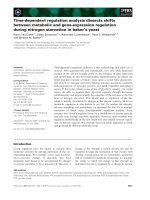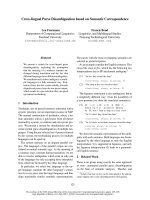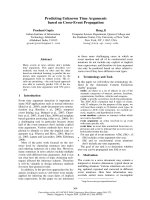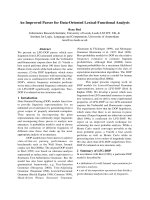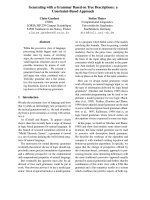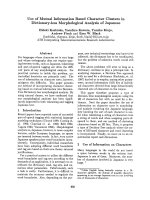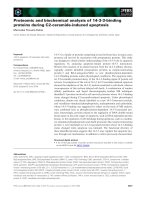Báo cáo khoa học: "Deverbal Compound Noun Analysis Based on Lexical Conceptual Structure" potx
Bạn đang xem bản rút gọn của tài liệu. Xem và tải ngay bản đầy đủ của tài liệu tại đây (24.85 KB, 4 trang )
Deverbal Compound Noun Analysis Based on Lexical Conceptual Structure
Koichi Takeuchi Kyo Kageura
Human and Social Information Research Division
National Institute of Informatics
2-1-2 Hitotsubashi, Chiyodaku, Tokyo 101-8430, Japan
koichi,kyo,t koyama @nii.ac.jp
Teruo Koyama
Abstract
This paper proposes aprincipled approach
for analysis of semantic relations between
constituents in compound nouns based on
lexical semantic structure. One of the
difficulties of compound noun analysis is
that the mechanisms governing the deci-
sion system of semantic relations and the
representation method of semantic rela-
tions associated with lexical and contex-
tual meaning are not obvious. The aim of
our research is to clarify how lexical se-
mantics contribute to the relations in com-
pound nouns since such nouns are very
productive and are supposed to be gov-
erned by systematic mechanisms. The
results of applying our approach to the
analysis of noun-deverbal compounds in
Japanese and English show that lexical
conceptual structure contributes to the re-
strictional rules in compounds.
1 Introduction
The difficulty of compound noun analysis is that the
effective way of describing the semantic relations
in compounds has not been identified. The descrip-
tion should not remain just a kind of categorization.
Rather, it should take into account the construction
of the analysis model.
The previous work proposed semantic approaches
based on semantic categories (Levi, 1978; Isabelle,
1984; Iida et al., 1984) had proposed detailed analy-
sis of relations between constituents in compound
nouns. Some of approaches (Fabre, 1996; John-
ston and Busa, 1998) take the framework of Gen-
erative Lexicon (GL) (Pustejovsky, 1995). Se-
mantic approaches are especially well designed but
they should still clarify the complete lexical factors
needed for analysis model.
Probabilistic approaches (Lauer, 1995; Lapata,
2002) have been proposed to disambiguate semantic
relations between constituents in compounds. Their
experimental results show a high performance, but
only for shallow analysis of compounds using se-
mantically tagged corpora. To be fully effective,
they also need to incorporate factors that are effec-
tive in disambiguating semantic relations. It is there-
fore necessary to clarify what kinds offactors are re-
lated to the mechanisms that govern the relations in
compounds.
Against this background, we have carried out a re-
search which aims at clarifying how lexical seman-
tics contribute to, independently of languages, the
relations in compound nouns. This paper proposes
a principled approach for the analysis of semantic
relations between constituents in compound nouns
based on the theoretical framework of lexical con-
ceptual structure (LCS), and shows that the frame-
work originally developed on the basis of Japanese
compound noun data works well for both Japanese
and English compound nouns.
2 The Basic Framework
2.1 The Relation between Modifier and
Deverbal Head
The relation between constituents in deverbal com-
pounds
1
can first be divided into two: (i) the modi-
fier becomes an internal argument (Grimshaw, 1990)
and (ii) the modifier functions as an adjunct. We as-
1
In the case of English the equivalent is nominalizations, but
for simplicity we use deverbal compounds.
sume these two kinds of relations are the target of
our analysis model because argument/adjunct rela-
tions are basic but extensible to more detailed se-
mantic relations by assuming more complex seman-
tic system. Besides these relations related to argu-
ment structure of verbs are the boundary between
syntax and semantics, then our approach must be ex-
tendable to be incorporated into sytactic analysis.
2.2 LCS-based Disambiguation Model
We assume that the discrimination between argu-
ment and adjunct relations can be done by the com-
bination of the LCS (we call TLCS) on the side of
deverbal heads and the consistent categorization of
modifier nouns on the basis of their behavior vis-`a-
vis a few canonical TLCS types of deverbal heads.
Figure 1 shows examples of disambiguating re-
lations using TLCS for the deverbal heads ‘sousa’
(operate) and ‘hon’yaku’ (translate). In TLCSes, the
words written in capital letters are semantics predi-
cates, ‘x’ denotes the external argument, and ‘y’ and
‘z’ denote the internal arguments (see Section 3).
Figure 1: Disambiguation of relations between noun
and deverbal head
The approach we propose consists of three ele-
ments: categorization of deverbals and nominaliza-
tions, categorization of modifier noun and restriction
rules for identifying relations.
3 TLCS
The framework of LCS (Hale and Keyser, 1990;
Rappaport and Levin, 1988; Jackendoff, 1990;
Kageyama, 1996) has shown that semantic decom-
position based on the LCS framework can system-
atically explain the word formation as well as the
syntax structure. However existing LCS frameworks
cannot be applied to the analysis of compounds
straightforwardly because they do not give extensive
semantic predicates for LCS. Therefore we construct
an original LCS, called TLCS, based on the LCS
framework with a clear set of LCS types and basic
predicates. We use the acronym “TLCS” to avoid
the confusion with other LCS-based schemes.
Table 1 shows the current complete set of TLC-
Ses types we elaborated.
2
The following list is for
Japanese deverbals, but the same LCS types are ap-
plied for nominalizations in English.
3
Table 1: List of TLCS types
1 [x ACT ON y]
enzan (calculate), sousa (operate)
2 [x CONTROL[BECOME [y BE AT z]]]
kioku (memorize), hon’yaku (translate)
3 [x CONTROL[BECOME [y NOT BE AT z]]]
shahei (shield), yokushi (deter)
4 [x CONTROL [y MOVE TO z]]
densou (transmit), dempan (propagate)
5 [x=y CONTROL[BECOME [y BE AT z]]]
kaifuku (recover), shuuryou (close)
6 [BECOME[y BE AT z]]
houwa (become saturated)
bumpu (be distributed)
7 [y MOVE TO z]
idou (move), sen’i (transmit)
8 [x CONTROL[y BE AT z]]
iji (maintain), hogo (protect)
9 [x CONTROL[BECOME[x BE WITH y]]]
ninshiki (recognize), yosoku (predict)
10 [y BE AT z]
sonzai (exist), ichi (locate)
11 [x ACT]
kaigi (hold a meeting), gyouretsu (queue)
12 [x CONTROL[BECOME [ [FILLED]y BE AT z]]]
shomei (sign-name)
The number attached to each TLCS type in Table
1 will be used throughout the paper refer to specific
TLCS types. In Table 1, the capital letters (such as
‘ACT’ and ‘BE’) are semantic predicates, which are
11 types. ‘x’ denotes an external argument and ‘y’
and ‘z’ denote an internal argument (see (Grimshaw,
1990)).
4
2
Basicaly these 12 types are set by the combination of argu-
ment structure and aspect analysis that is telic or atelic. After
applying all the combination, we arrange the TLCS patterns by
deleting patterns that does not appear and subcategorizing cer-
tain patterns.
3
At the moment, there are about 500 deverbals in Japanese
and 40 nominalizations in English.
4
In this paper, we limit the types of arguments are three, i.e.
x (Agent), y (Theme) and z (Goal).
4 Categorization of Modifier Noun
4.1 Categorization by the Accusativity of
Modifiers
In Japanese compounds, some of modifiers can not
take an accusative case. This is an adjectival stem
and it does not appear with inflections. Therefore,
the modifier is always the adjunct in the compounds.
So we introduce the distinction of ‘-ACC’ (unac-
cusative) and ‘+ACC’ (accusative).
ACC ‘kimitsu’ (secrecy) and ‘kioku’ (memory) are
‘+ACC’, and ‘sougo’ (mutual-ity) and ‘kinou’
(inductiv-e/ity) are ‘-ACC’. In English, they
correspond to adjective modifier such as ‘-ent’
of ‘recurrent’ or ‘-al’ of ‘serial’.
4.2 Categorization by the Basic Components of
TLCS
If, as argued by some theoretical linguists, the LCS
representation can contribute to explaining these
phenomena related to the arguments and aspect
structure consistently, and if the combination of LCS
and noun categorization can explain properly these
phenomena related to argumet/adjunct, then there
should be a level of consistent noun categorization
which matches the LCS on the side of deverbals. We
used the predicates of some TLCS types to explore
the noun categorizations.
In the preliminary examination, we have found
that some TLCS types can be formed into the groups
that correspond to modifier categories in Table 2.
Below are examples of modifier nouns catego-
rized as negative or positive in terms of each of these
TLCS groups.
ON ‘koshou’ (fault) and ‘seinou’ (performance)
are ‘+ON’, and ‘heikou’ (parallel) and ‘rensa’
(chain) are ‘-ON’. (‘ON’ stands for the predi-
cate in ‘ACT ON’.)
EC ‘imi’ (semantic) and ‘kairo’ (circuit) are ‘+EC’,
and ‘kikai’ (machine) and ‘densou’ (transmis-
sion) are ‘-EC’. (‘EC’ stands for an External
argument Controls an internal argument’.)
AL ‘fuka’ (load) and ‘jisoku’ (flux) are ‘+AL’, and
‘kakusan’ (diffusion) and ‘senkei’ (linearly) are
‘-AL’. (‘AL’ stands for alternation verbs.)
UA ‘jiki’ (magnetic) and ‘joutai’ (state) are ‘+UA’,
and ‘junjo’ (order) and ‘heikou’ (parallel) are
‘-UA’. (‘UA’ stands for UnAccusative verbs.)
5 Procedure of Compound Noun Analysis
The noun categories introduced in Section 4 can
be used for disambiguating the intra-term relations
in deverbal compounds with various deverbal heads
that take different TLCS types. The range of ap-
plication of the noun categorizations with respect to
TLCS groups is summarized in Table 2. The num-
ber in the TLCS column corresponds to the number
given in Table 1.
Step 1 If the modifier has the category ‘-ACC’, then
declare the relation as adjunct and terminate. If
not, go to next.
Step 2 If the TLCS of the deverbal head is 10, 11,
or 12 in Table 1, then declare the relation as
adjunct and terminate. If not, go to next.
Step 3 The analyzer determines the relation from
the interaction of lexical meanings between a
deverbal head and a modifier noun. In the case
of ‘-ON’, ‘-EC’,‘-AL’ or ‘-UA’, declare the re-
lation as adjunct and terminate. If not, go to
next.
Step 4 Declare the relation as internal argument and
terminate.
With these rules and categories of nouns, we
can analyze the relations between words in com-
pounds with deverbal heads. For example, when
the modifier ‘kikai’ (machine) is categorized as
‘-EC’ but ‘+ON’, the modifier in kikai-hon’yaku
(machine-translation) is analyzed as adjunct (that
means ‘translation by a machine’), and the modi-
fier in kikai-sousa (machine-operation) is analyzed
as internal argument (that means ‘operation of a ma-
chine’), both correctly.
6 Experiments and Evaluations
We applied the method to 1223 two-constituent
compound nouns with deverbal heads in Japanese.
809 of them are taken from a dictionary of techni-
cal terms (Aiso, 1993), and 414 from news articles
in a newspaper. We also applied the method to 200
compound nouns of technical terms (Aiso, 1993) in
English. They are extracted randomly.
According to the manual evaluation of the exper-
iment, 99.3% (1215/ 1223) of the results were cor-
rect in Japanese, and 97% (194/200) in English. The
performance is very high. Table 2 shows the details
of how the rules are applied to disambiguating the
relations between constituents in the deverbal com-
pounds. These results indicate that our set of LCS
and categorization of modifiers has the enough to
disambiguate the relationships we assumed.
Table 2: Combination of modifiers and TLCS of de-
verbal heads,and statistics of the correct analysis
role mod. cat. TLCS Jap.(%) Eng. (%)
adjunct -ACC any 263 (36.7) 84 (75.0)
any 10,11,12 88 (12.3) 4 (3.6)
-ON 1 95 (13.3) 10 (8.9)
-EC 2,3,4 186 (25.9) 14 (12.5)
-AL 5 26 (3.6) 0 (0.0)
-UA 6,7 59 (8.2) 0 (0.0)
total 717 112
role mod. cat. TLCS Jap.(%) Eng.(%)
int. argu. +ACC 8, 9 74 (14.9) 15 (18.3)
+ON 1 89 (17.9) 19 (23.2)
+EC 2,3,4 249 (50.0) 43 (52.4)
+AL 5 57 (11.4) 3 (3.7)
+UA 6,7 29 (5.8) 2 (3.4)
total 498 82
7 Discussion
Roughly speaking, our LCS-based approach can be
available both Japanese and English deverbal nouns.
Comparing with the results between Japanese com-
pounds and English compounds, the factor ‘-ACC’
looks effective to disambiguate relations. The rea-
son is that the most of modifiers indicate adjec-
tive function by adding suffixes in English. While
in Japanese, adjectival nouns of modifiers have no
inflecitons, then the semantic-based approach is
needed for Japanese compound noun analysis.
We found that a small number of modifier nouns
deviate from our assumptions. The most typical case
is that our analysis model fails in a word with mul-
tiple semantics. For example, ‘right justify’ is mis-
understood as internal argument relation because of
ambiguity of the word ‘right’ which has both mean-
ings of an adjective and a noun. We consider dealing
with them as each different words like ‘right
adj’,
‘right
noun’ in future work.
8 Conclusion
This paper proposes a principled approach for anal-
ysis of semantic relations between constituents in
compound nouns based on lexical conceptual struc-
ture we call it TLCS. The results of experiment for
Japanese compounds and English compounds show
our approach is highly promising, also the contribu-
tion of the lexical factor to disambiguation rule.
References
Hideo Aiso. 1993. Dictionary of Technical Terms of In-
formation Processing (Compact edition). Ohmusha.
(in Japanese).
Cecile Fabre. 1996. Interpretation of Nominal
Compounds: Combining Domain-Independent and
Domain-Specific Information. In Proceedings of
COLING-96, pages 364–369.
Jane Grimshaw. 1990. Argument Structure. MIT Press.
Ken Hale and Samuel J. Keyser. 1990. A View from the
Middle Lexicon (Lexicon Project Working Papers 10).
MIT.
Jin Iida, Kentaro Ogura, and Hirosato Nomura. 1984.
Analysis of Semantic Relations and Processing for
Compound Nouns in English. In Proceedings of Infor-
mation Processing Society of Japan, SIG Notes,NL,46-
4 (in Japanese), pages 1–8.
Pierre Isabelle. 1984. Another Look at Nominal Com-
pounds. In Proceedings of COLING-84, pages 509–
516.
Ray Jackendoff. 1990. Semantic Structures. MIT Press.
Michael Johnston and Federica Busa. 1998. The Com-
positional Interpretation of Nominal Compounds. In
E. Viegas, editor, Breadth and Depth of Semantics Lex-
icons. Kluwer.
Taro Kageyama. 1996. Verb Semantics. Kurosio Pub-
lishers. (In Japanese).
Maria Lapata. 2002. The Disambiguation of Nomi-
nalization. Association for Computational Liguistics,
28(3):357–388.
Mark Lauer. 1995. Designing Statistical Language
Learners: Experiments on Noun Compounds. Ph.D.
thesis, Department of Computing, Macquarie Univer-
sity.
Judith N. Levi. 1978. The Syntax and Semantics of Com-
plex Nominals. Academic Press.
James Pustejovsky. 1995. The Generative Lexicon. MIT
Press.
Malka Rappaport and Beth Levin. 1988. What to do
with
-roles. In W. Wilkins, editor, Thematic Rela-
tions (Syntax and Semantics 21), pages 7–36. Aca-
demic Press.
